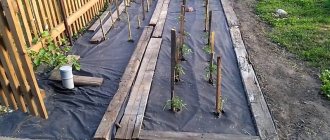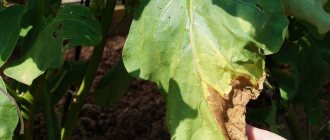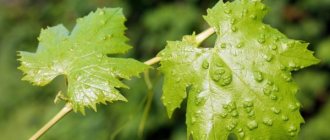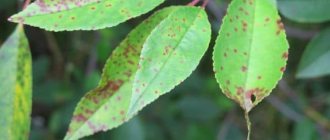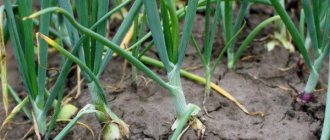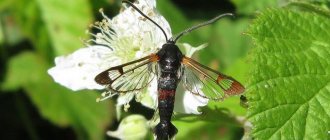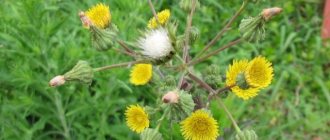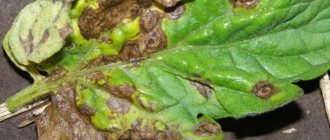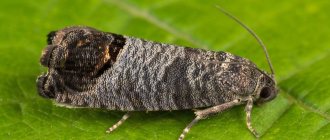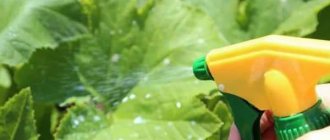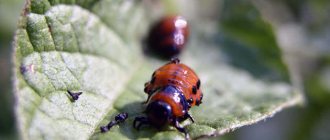The gall pear mite, or otherwise gall midge, is a harmful insect that weakens the fruit plant. The parasite is extremely small, you can see it in a photo or under high magnification on a plant, because of this its presence is determined by comparing the condition of the tree with the description of its attack. The gall mite may not be noticeable on a pear, but it is one of the pests that often affects garden crops. Therefore, it is advised to prevent the appearance, even when there are no signs of an attack yet. Measures to combat mites on pear trees have been worked out; there are many drugs that can be used to treat the plant.
Gall mite and natural habitat
The gall midge or gall mite on a pear tree parasitizes by consuming plant juices, which significantly weakens the fruit tree affected by it. The result of the life activity of this pest is a reduction in the volume of the harvest (loss of about 95%) and a drop in the commercial quality of the fruit. The parasite survives the cold season in the buds; after sap flow is activated, it damages the foliage and fruits. Fruits do not form from affected buds. In addition to pears, it also attacks the following fruit crops:
- quince trees;
- hawthorn;
- rowan;
- dogwood;
- apple trees.
Treatment
Even with a severe infestation of pears, a gardener can quickly get rid of gall mites.
The choice of a specific pest control product depends on the degree of infestation of the garden and the period when the mite was noticed (before the flowers appear or after the start of flowering). The greatest effectiveness in combating the parasite is provided by a combination of traditional methods, agricultural technology and chemicals, as well as the alternation of various acaricides and insecticides used to treat pears. Find out about the Miracle cherry variety here.
Agrotechnical methods
If the pest population is small on the site, it can be controlled using agrotechnical methods. The following techniques give a good effect:
- Using mineral fertilizers to feed plants. They help reduce the osmotic pressure in cell sap, which makes it difficult for ticks to feed.
- Whitewashing of trees, regular removal of old bark from the trunk and large branches. This reduces the number of parasites.
- Removing weeds from the site, old leaves and fruits. This reduces the risk of pests appearing in your area and prevents their further reproduction.
Signs of a pest attack
Often, gardeners begin to fight the gall mite only after signs of its attack and deterioration in the condition of the fruit tree appear. This approach does not always give the desired results, since it is impossible to save already affected pear buds and because of this it is better to act in advance by preventing its occurrence. However, in some situations, preventive measures are useless; the gall mite still appears on the pear.
There are characteristic signs of its activity. Thus, buds damaged by the pest are delayed in development by approximately a couple of weeks. When some of the flower or leaf buds have already opened, but others, albeit quite large, have not yet, we can assume the presence of a parasite in them. It is recommended to focus more attention on the middle and lower parts of the crown, next to the central conductor (trunk). After emerging from the buds, the females begin to live by sucking juices from young foliage. They also make a puncture in the leaf and lay eggs in the leaf blade.
It may be interesting How and with what to treat a pear in the spring against pests and diseases. Pear leaves turn black: causes and treatment methods. How and with what to feed a pear in the fall
The exact signs of a gall midge attack are:
- First, at the puncture sites, faded green marks up to 3 mm appear, which are concentrated on the back of the leaf plate along the central vein.
- Gradually, these plaques change their shade to dirty brown and grow, occupying virtually the entire back part of the leaf blade.
- The convex brownish growths gradually darken and merge into one spot on the already deformed leaf plate, which falls off at this stage.
The larvae that hatch from laid eggs use foliage as food, and after they mature, they give rise to the next generation of pests. Adult individuals of harmful insects are able to independently move from one fruit tree to another. However, there are some factors that increase the likelihood of their occurrence on a still healthy pear tree, they are as follows:
- excessive crown density;
- application of extremely large volumes of phosphorus-containing fertilizers;
- lack of regular sanitary pruning.
Attention!
Plant stimulants sometimes increase the mite population. Also, the gardener needs to comprehensively consider the solution to the issue of how to deal with gall mites, since some insecticides destroy their natural enemies - ground beetles, dragonflies and the like, but are harmless to gall midges.
Why are pests dangerous?
Pests in the garden and vegetable garden are the main enemies of the summer resident. The main problem is that insects are constantly evolving and developing stable immunity to various pesticides and drugs. A product that showed effectiveness last season and quickly destroyed the pest turns out to be completely ineffective in the new year.
This problem can be solved. The basic rule for using insecticides is to regularly change their active component. This way, insects will not have time to acquire resistance to the drugs.
Pests can cause significant damage to plantings. The danger is as follows:
- the general immunity of the plant decreases;
- frost resistance decreases;
- the gardener receives a smaller harvest;
- There is a risk of viral, bacterial and fungal diseases transmitted by insects.
If you do nothing, the pests actively multiply, form entire colonies and suck all the juices out of the plants. The tree gets sick and then dies. The danger also lies in the fact that it is difficult to remove insects if they spread en masse. The use of powerful drugs in high doses on affected plants will not produce results.
How to solve the problem of gall midge on a pear tree
On a pear tree, the fight against mites is a rather long and relatively complex process, since this harmful insect penetrates into the tissues of the plant and contact preparations are in many cases powerless. To solve the problem of gall midges on a pear tree, you need an integrated approach and alternation of the preparations used by the gardener. But, if the infection is primary and detected in a timely manner, then in the spring or in the first days of July, the parasite can be destroyed simply by tearing off the damaged foliage and carrying out preventive treatment.
Sometimes gall mites have resistance to acaricides. Because of this, several drugs are used alternately during treatment. This helps slow down the growth of the mite population on the pear. The main method of eliminating colonies of harmful insects is treatment with chemicals containing phosphorus and sulfur. The general tactics of how to deal with gall mites on a pear when there is already damage involves 3 stages, performed at different times:
- after warming, when the pest leaves the buds;
- upon completion of the flowering phase of the pear tree;
- after harvesting the fruits until it gets colder, when the parasites go into hibernation.
hawthorn
This is a voracious pest that will quickly destroy all leaves, flowers and buds. The tree will be left with bare branches.
The insect goes to hibernate in houses made of dry leaves. The easiest time to detect a colony is in the fall, when all the leaves have fallen.
Only timely methods of pest control can cope with the scourge. Experienced gardeners recommend removing all hawthorn nests from trees. And in the summer, pest butterflies can be collected from weed flowers in the evenings, where they sit for the night.
Hawthorn is afraid mainly of insecticides. Trees must be treated in the spring before bud formation begins.
Preventing the appearance of gall midges
To prevent the occurrence of gall mites on pear crops, at the beginning of spring, preventive spraying of trees is carried out along the whitish and green contour of the buds. Iskra M, 30 Plus or other bio- and chemical products are suitable for this. In addition to preventive spraying, the gardener needs to comply with agrotechnical standards and perform sanitary treatments of the tree:
- free skeletal branches and the central shoot from old, receding bark;
- remove fallen leaves and other plant debris from the area in the fall;
- perform sanitary pruning and prevent crown thickening;
- dig up soil in the tree trunk circle;
- whitewash the trunk.
When spraying with anti-mite preparations was not possible on time, it can be done at the end of the flowering phase. But by this time some of the females have already managed to lay eggs. When there is a lot of foliage and it is damaged, which was discovered in the summer, the gardener needs to use not only compounds against pear mites, but also spray preparations that eliminate other types of parasites. Even when there are no signs of the appearance of gall midges, it is recommended to carry out pest prevention - for this, foliar feeding is performed (the crown is sprayed with a nutrient composition). The composition is prepared independently:
- a bucket of water;
- 0.1 kg of urea;
- 3 g boric acid;
- 5 g copper sulfate;
- 3 g potassium permanganate.
This product can be used simultaneously with pesticides. The result of this feeding is stimulation of plant development. Also, weeds are a natural habitat for harmful insects, so the gardener needs to promptly remove them from the site and burn the plant residues. In gardens where weeds are removed in a timely manner, due to a lack of food supplies for parasites, the concentration of sucking parasites decreases. Because of this, it is also necessary to keep the soil under cultural turf (grasses are sown and periodically mowed) or fallow (systematic loosening and digging).
On a note!
In addition to mites, leafhoppers, aphids and some other harmful insects live and overwinter on weeds.
The gall mite, which parasitizes the pear, is capable of destroying virtually the entire fruit crop and providing suitable conditions for the emergence of various diseases of the garden crop. It is possible to solve the problem; this requires systematic care of the plants, as well as sanitary pruning and taking measures to prevent thickening of the crown. Preventive treatments with biological and chemical preparations are also required. When a harmful insect is already present, it must be dealt with in several stages and using different means - only an integrated approach can solve the problem.
Mechanism of gall formation
The process of formation of growths resembles the process of spread of inflammatory processes in the human body.
In addition, the formation mechanism has its own characteristics:
- A gall forms at the site of injury (insect bite);
- The growth can form not only on the leaves, but also on all other parts of the plant;
- The size of the galls can vary: from a few centimeters to huge growths.
There are several types of insects whose bites can provoke development, the most common are gall mites:
- They belong to the superfamily of arachnids and the order of acarimorphic mites;
- They have small body sizes: from 0.1 to 0.6 mm;
- No sense of smell;
- By biting a plant, they feed on it, destroying the tissue structure of the leaf.
In some cases, the formation of galls is caused not only by the presence of a bite. So, for example, a female gall moth lays a larva in an oak leaf bud, which there carries out a cycle of transformation into an adult. As a result, a growth forms on the leaf, surrounding the larva - a gall.
Location Features:
- Galls on pear leaves are arranged in rows parallel to the central vein of the leaf;
- On the leaves of the apple tree, they are located all over the leaf. There are especially many of them on the underside;
- Galls on willow leaves are represented by chains of convex growths on both sides of the leaf.
Do not underestimate the harm of the gall mite. Affected leaves do not go through the full growing season, but dry out and fall off prematurely.
In addition, the gall mite can infect not only leaves, but also young shoots and buds, which negatively affects the level of plant productivity.
Plum papilion
This is an inconspicuous hymenopteran parasite with transparent wings, whose black body is up to 1 cm long, and flies out when the plum blossoms. Females actively lay eggs in the formed ovary: approximately 40 eggs. The larvae of the fat stalk develop inside the fruit, feed on it, and provoke the fall of unripe plums, usually in mid-summer.
The plum stalk overwinters in unformed fruits. Young insects will fly out in the spring to lay eggs on plum plantings.
Control methods and prevention
The carrion should be removed promptly. An effective way to counteract the plum stalk is to treat the tree after flowering for 7 days after the plum petals fall.
In the future, it is advisable to attract beneficial insects to the garden plot, which will help get rid of plum pests. Honey plants are planted:
- raspberries and clover;
- coriander and sunflower;
- lemon balm and sage.
Beginning gardeners often mistake false scale or scale insects for droplets of gum that have frozen, and for growths on the bark.
Distinctive features of both types:
- inactivity;
- excellent camouflage.
Pests directly dig into young branches and leaves, growing into them and intensively sucking out the juices of the tree. Only young individuals, as well as males, move. Massive plum infection threatens:
- weakening of fragile plantings;
- drying out and falling of leaves;
- loss of fruits;
- death of trees.
Measures not taken in a timely manner make it difficult to fight scale insects. The insects reproduce at a rapid rate and produce honeydew, a favorite habitat for sooty fungus, which makes breathing difficult and inhibits growth.
The differences between scale insects and false scale insects lie in shape. The first parasite has a flattened scutellum. The false scale resembles a hemisphere, in addition, it is not absorbed into the bark, detaches mechanically and does not exude honeydew.
Control methods and prevention
If the scale insect is on a drain, the methods of control are chemicals coupled with folk remedies.
They fight false scale insects in the same way as when infecting plants with scale insects. Parasites are removed with a brush and the branches are treated with kerosene with the addition of laundry soap or a mixture based on alcohol and soap.
Covering large areas with insects is a reason to turn, along with folk remedies, to methods of chemical protection. Spraying is carried out several times with a break of a week.
